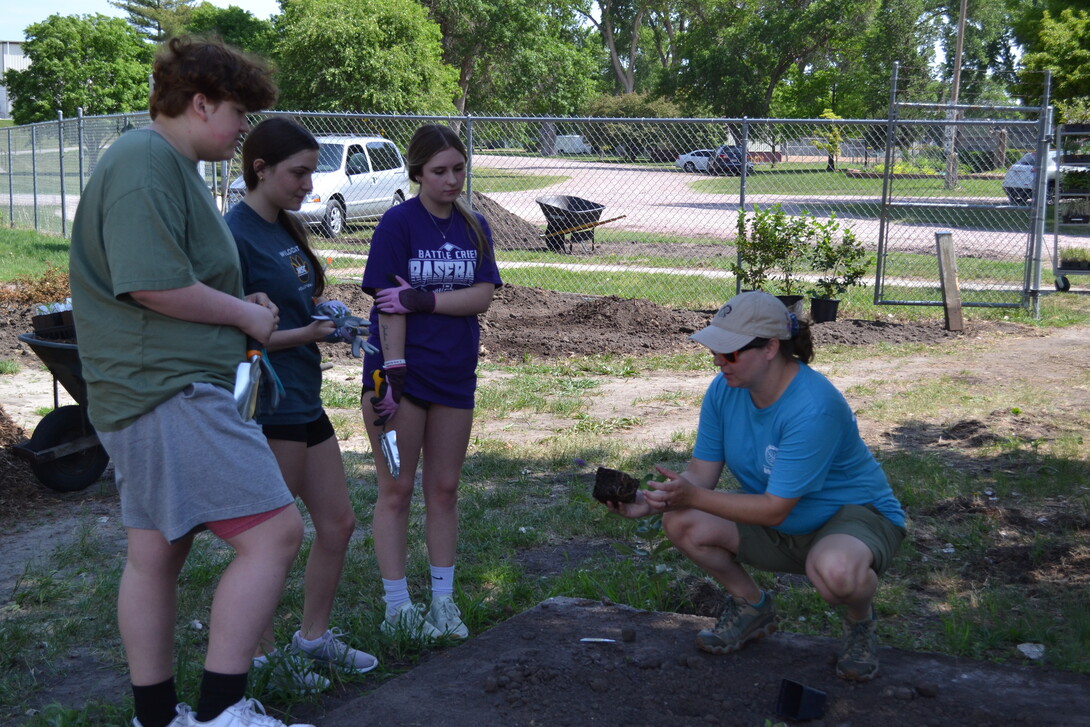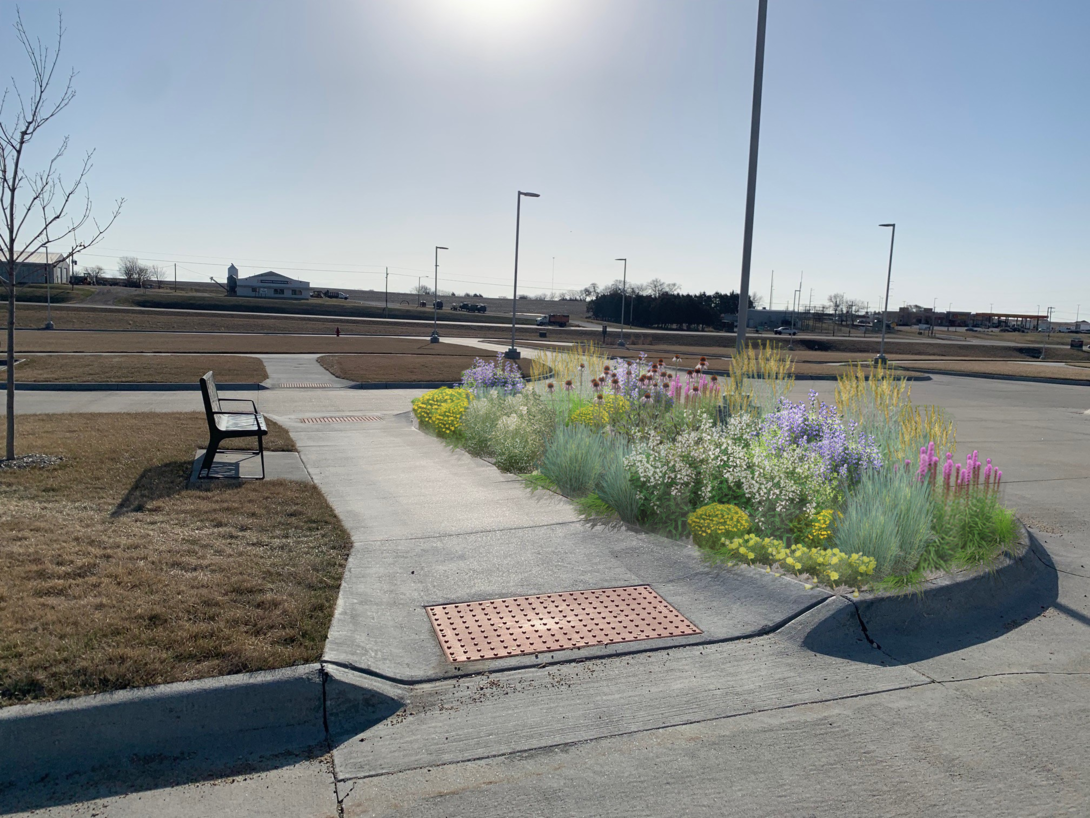
Nebraska Statewide Arboretum grant programs allow communities to plant with a purpose, whether it is sharing the area’s history or providing therapeutic environments.
Staff members at the Nebraska Statewide Arboretum and Nebraska Forest Service are working around the state to reintroduce native species in a way that serves each town and its people. The Arboretum is a network of sites, parks, historic properties and other public landscapes in dozens of communities across the state, all supported by the University of Nebraska–Lincoln.
Sarah Buckley, sustainable landscape specialist, said in addition to being good for the state’s ecosystems, being thoughtful about installing native plants creates an experience unique to Nebraska.
“You can get beauty from any flowers, but we create a sense of place with native plants,” Buckley said. “They look like Nebraska. That’s one thing that native plants do that any old landscaping plant can’t do as well.”
Greener Towns, Trees for Nebraska Towns and other programs the Arboretum offers allow entities like cities, schools or volunteer groups to apply for reimbursement of 50% of the cost of a project.
“We’re trying to increase their capacity for their money, but then we also work closely with them to plan the project and guide them,” Buckley said.
Sharing history through plants
In June, staff and local volunteers planted a variety of native species at a park in Battle Creek, Nebraska, through a Greener Towns grant. The town took on a revitalization project at Heritage Park, where they’ve moved buildings with connections to local history, including the founding doctor’s office, a Czech cabin, and an old schoolhouse.
Buckley said the team created a functional landscape and drew upon the town’s history of the Pawnee people and early Europeans in the region to inspire plant selection.
“We used these gardens to create a way for people to walk in and know where to go, but also highlight plants of significance to the Pawnee people since that was historically their land, and recreating the landscape the settlers would have come upon and plants that would have become important to them,” said Buckley, who served as coordinator for the project.
The team chose plants that served specific purposes in that area, such as purple coneflower and yarrow, which they used medicinally; milkweed and prairie willow, used for textiles; and white sage, used in religious practices. Some, like serviceberry, sand cherry and wild plum, were food sources. Buckley said Battle Creek’s museum plans to use those plants to hold cooking demonstrations.

Buckley said the group handed her a story to tell, which made the project not only easier, but more exciting.
“A landscape can just be there in the background or it can be an interactive part of a space, and to do an interactive part and have a story to tell is very exciting,” Buckley said. “It gives a reason behind each plant I chose. It’s so much more of a connection between the people, the landscape and the history.”
Buckley said the team installed big and little bluestem, silphium and penstemons to recreate what the region looked like before it was used for agriculture.
Battle Creek will host a ribbon cutting Aug. 3 at the park as part of the town’s 150th anniversary celebration.
“Our vision for the Battle Creek Heritage Park was to bring native plants and grasses to the space to beautify and as an educational resource; however, we were no experts,” said Marcie Sextro, member of the Heritage Park Revitalization Committee. “So we reached out to the Nebraska Statewide Arboretum, and with their help and matching grant, we could install an extensive planting of plants, trees and shrubs that our town will enjoy for years to come.”
Nature’s healing effect
Another Arboretum project aims to add to a comforting and healing environment at a hospital in Syracuse, Nebraska. Volunteers there, in conjunction with the Nebraska Forest Service, are planning for native plants along a walking trail around the hospital, trees for a windbreak and gardens in “comfort stations” around the exterior of the facility.
“We have identified our vision statement for this project as ‘Utilizing nature to inspire a healthy and healing environment for our patients and community,’” said Jill Ford, vice president of marketing and development for the Syracuse Area Health Center. “We are excited to partner with the Nebraska Forest Service and the Nebraska Statewide Arboretum and are very thankful for our amazing local volunteers who are a huge asset to this project.”
Brad Kindler, sustainable landscape specialist and coordinator for the project, said staff examined the soil, the area’s irrigation needs and other environmental factors when deciding which plants will go into a space. Kindler also worked as a designer on the Battle Creek project.
“We’re adamant about planting the right plants in the right place,” Kindler said.
They also consider when each plant blooms so some will bloom in the spring, others will fill in during the summer and more in the fall. Kindler said it is also a priority to select plants that will be good for local pollinators and other wildlife, aiding the local ecosystem.
“Having multiple seasons of flowers is beautiful for humans, but it’s also helping nature,” Kindler said.

Kindler said planting on the project will likely begin this fall and possibly extend into the following spring. He said gardens like the ones they are planning in Syracuse can have a healing effect by comforting people.
“Putting native plants back into the landscape around this area provides an opportunity for people there looking for comfort or healing or solace or beauty to be able to find that in the landscape in and around the space where they’re getting their treatment,” Kindler said. “When we’re able to reintroduce these species back into the landscape, we’re supporting the whole ecosystem of pollinators and other species so it’s an opportunity to provide a little bit of healing in the landscape, too.”
Buckley said these plants often need less water and require less maintenance. Also, planting varied native species creates a more sustainable environment.
“Native plants and the biodiversity they provide provides habitat for birds and insects and small animals and things we will lose from our urban spaces if we don’t take care with that,” Buckley said.







